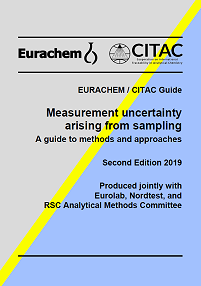The Fitness for Purpose of Analytical Methods (2025)
Full title
The Fitness for Purpose of Analytical Methods: A Laboratory Guide to Method Validation and Related Topics: Third edition (2025)
Quick links:
- Overview of the guide
- Downloads
- Citing the guide
- Supplementary guidance on method validation topics
- Previous versions
Introduction
 |
This guide was first issued in 1998 and the second edition published in 2014. Over the years it has been one of the most popular of the Eurachem guides. Since the release of the first edition, however, there have been many changes in terminology, working practices, reference documents and requirements. This third edition, produced by the Eurachem Method Validation Working Group, forms a thorough revision of the 2014 edition. This third edition includes a section on sampling and sample handling as ISO/IEC 17025:2017 introduced a focus on sampling associated with the testing or calibration being carried out by the laboratory and further guidance on assessing the calibration function has been included. The Guide is also now supported by a number of supplementary guidance documents – please see the section on supplementary guidance below. |
Contents
This third edition includes guidance on:
- The importance of fitness for purpose;
- The concept of method validation and verification;
- How a method validation or verification study should be performed and how much should be done;
- Sampling and sample handling in relation to method validation;
- A thorough explanation of the various validation parameters (performance characteristics) and related topics;
- Follow-up on the validation study (reporting, use of performance data in Internal Quality Control);
- Documentation of analytical methods.
Annexes also describe the statistical basis of detection limits and analysis of variance for precision studies, and add a check list to aid users in selecting and determining the validity of a test kit.
In preparing this guidance, the Working Group has aimed at the right balance between giving a solid theoretical background for method validation studies and providing practical guidelines on how to plan, perform and evaluate such studies in the laboratories.
The approach is generic in the sense that the Guide does not focus on particular fields of application (food, environment, pharmaceuticals etc.). However, the guide includes references to a number of specific guides in fields where different practices have been developed and become common.
The guide also includes a full bibliography. Further literature references on method validation can be found in the section "Validation of analytical methods" in the Reading list on this website.
Availability
You can download the Guide here at no cost:
- Download the guide in English (Issued 2025) (pdf, 2.01 MB)
The second edition of this Guide is available in a number of translations. For details see previous editions below.
Citation
This publication should be cited* as:
"H. Cantwell (ed.) Eurachem Guide: The Fitness for Purpose of Analytical Methods – A Laboratory Guide to Method Validation and Related Topics, (3rd ed. 2025). Available from http://www.eurachem.org"
*Subject to journal requirements
Supplementary guidance
The supplementary guidance below gives additional guidance on method validation topics:
- Planning and reporting method validation studies. This supplement is in the form of a template which can be used to assist with planning the evaluation of the chosen performance characteristics
- Blanks in method validation. This short supplement describes the different types of blanks which may be used during method validation and provides guidance for situations where it may be difficult to obtain a suitable blank matrix.
Translations
Translation into other languages is permitted for members of Eurachem. Other offers of translation should be directed to the Eurachem Secretariat for permission. The Eurachem policy on maintenance and development of Eurachem guidance, available on the Policies page, gives further information on translation.
Previous version
The 2014 edition of this guide can be found here for reference.


 Measurement uncertainty arising from sampling: A guide to methods and approaches
Measurement uncertainty arising from sampling: A guide to methods and approaches